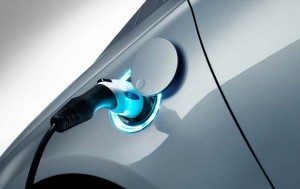Ford set automotive design on its head when it launched the current Fusion sedan four years ago. How do you follow up on such a big hit? We’ll find out when the 2017 version of the sedan makes its debut at the North American International Auto Show in Detroit next month.
Ford teased the new model during a media briefing on Thursday, a draped sedan marked with a sign declaring, “Top Secret: Do not move until 01.11.2016.” Based on some recent spy shots, the 2017 Ford Fusion is expected to undergo relatively modest design tweaks. The biggest news is expected to be found under the hood in the form of an updated plug-in hybrid drive.
The next-gen Ford Fusion Energi model is part of an aggressive push by the maker that will see it invest $4.5 billion in “electrified” vehicles between now and 2020. Ford’s list of hybrids, plug-ins and pure battery-electric vehicles, or BEVs, will grow by 13 nameplates. It currently offers six battery-based vehicles.
(Ford investing $4.5 bil in new electrified vehicles by 2020. Click Here for details.)
The silhouette of the 2017 Ford Fusion is likely to go unchanged from the current model. The most notable updates, according to spy shots and industry insiders, will come up front. In keeping with current industry trends, expect to see an even larger version of the Fusion’s signature trapezoidal grille, now framed by LED daytime running lamps and more chrome.
The interior will likely see a few changes. Ford has been pushing to upgrade its cabins with more plush, soft-touch materials. And we could see a few more knobs, as consumers continue to push back from the industry’s switch to mostly touchscreen controls.
That’s in line with the addition of Sync 3, the latest update of the maker’s well-known, if controversial, infotainment system. Raj Nair, Ford’s Chief Technology Officer, said Thursday that the maker focused on seeing how customers actually used the system, rather than simply trying to come up with the latest-and-greatest in technology.
(Ford explores ride-sharing, multi-modal and other mobility options. Click Here for the story.)
As before, the midsize Fusion will be offered with a mix of powertrains, including Ford’s turbocharged EcoBoost option. There will be a conventional hybrid and a revised version of the Energi plug-in system.
While company officials wouldn’t discuss specific product plans at the Thursday backgrounder briefing, they offered some broad hints.
Among the key improvements, expect to see lighter, more powerful and compact components, including the motor drive system and the Fusion Energi’s lithium-ion battery pack, suggested Kevin Layden, director of Ford’s Electrification Powertrain Engineering operations.
Costs should come down, as well, Layden saying, “We’re getting 10 to 20% off the cost (of the technology) with each design iteration.”
How much of that will be passed onto consumers is uncertain, but the high cost of battery-based vehicles has been seen as a major issue in terms of generating more widespread demand – especially at a time when gasoline prices are tumbling.
Also uncertain is whether Ford will boost the Fusion Energi’s range in electric-only mode. The current model delivers 21 miles per charge. If unchanged, that would be only about 40% of the range of the 2016 Chevrolet Volt, which saw a big bump in second-gen form to 53 miles per charge.
(Ford gets Siri-ous with new Sync software update. Click Here for the story.)


